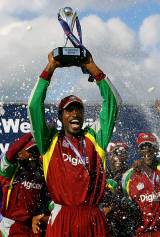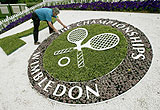
|

The series was won, deservedly, by West Indies, but did anyone notice?
© Getty Images
|
|
British sports lovers have been having a feast over the past few days. We've had the British Grand Prix, the tennis at Wimbledon and the Tour de France. Most people didn't even notice that there was also some one-day international cricket going on.
The series was won, deservedly, by West Indies. They bowled better, fielded better and mostly batted better than England, who, typically, responded to a World Cup failure by changing several players but omitted to change their game. England's top three were too slow, Kevin Pietersen had a rare poor series, and their bowling in the middle overs had all the cutting edge of a set of toy knives.
In the battle of the unexpected captains, Paul Collingwood did pretty well, making only two real mistakes - moving himself from backward point (his fielding is worth more than his captaincy at this stage) and shrugging his shoulders after James Anderson turned cricket into a contact sport (the senior pro can do that, the captain can't). But Chris Gayle did even better, displaying more flair - seven slips! - and a visible desire which fired up a hot-and-cold team. Not for the first time, a bad boy showed more of a gift for captaincy than a solid
citizen.
But even more than most one-day series, this one is destined to be forgotten. So I want to talk about something else. On Thursday, I went to Wimbledon. My mum had got tickets in her local tennis-club ballot and she kindly took me along. Centre Court wasn't quite itself, as somebody seemed to have removed the roof. The weather gods were unable to resist the temptation to break a few rain records, but in between the torrents we saw a good, tight, fluctuating game between two eastern European women, Ana Ivanovic and Nicole Vaidisova, neither of whom looked remotely capable of withstanding the force of Venus Williams in the next round.
 Coming from cricket, I was very struck by something. No, not the presence of women on centre stage. It was the absence of advertising. There is a little, but it is very, very discreet.
Coming from cricket, I was very struck by something. No, not the presence of women on centre stage. It was the absence of advertising. There is a little, but it is very, very discreet.
 |
Coming from cricket, I was very struck by something. No, not the presence of women on centre stage. It was the absence of advertising. There is a little, but it is very, very discreet. The manufacturers' logos on the players' kit aren't visible from most of the seats. On
the green-striped lawn, much wider than the court itself, there is plenty of room for billboards, but Wimbledon doesn't have any. There are only two brand names in sight at all: IBM and Rolex. IBM appears on the little board that gives the speed of the last serve; Rolex is on the main scoreboard. And that's it.
Both these famous names appear in yellow, on the dark green background that is Wimbledon's signature. Neither logo is big, let alone in your face. Their branding is like a genial journeyman in a mixed-doubles pair who has landed a very talented partner: clearly secondary. In fact, tertiary. First comes the game. Second comes the branding of the
All-England Lawn Tennis Club - the dark green, the retro smartness of the line judges, the crisp efficiency of the servicemen and women who act as stewards. (Somehow, the fluorescent jacket has yet to catch on here.) The sponsors come a perfectly respectable third.
Wimbledon doesn't renounce commerce altogether. It could, if it wished, have no brand names at all. But it only has two, they are small and discreet, and at least one of them (IBM) is part of the operation, supplying instant scores to the Wimbledon website. The contrast with the other major sports is startling. Football is so blindly commercial that it now happily distracts players and spectators with video billboards. Motor racing makes as much noise with logos as it does with its engines. And cricket, which has the most in common with tennis - clubbiness, gentility, stop-start rhythm, passages of silence - has
gone in a very different direction.

|

Wimbledon doesn't renounce commerce altogether. It could, if it wished, have no brand names at all
© Getty Images
|
|
If Lord's were run by the All-England Club, there would be no sponsors' mats on the field, no company name emblazoned across the players' shirts, no necklace of billboards around the boundary. The Test series would not be called the nPower Test series, and the one-day series would not be sponsored by a bank. I'm not knocking these sponsors, who
have been good to cricket. I am knocking the administrators, for not knowing where to draw the line. All these concessions to commerce have come in the past 35 years, and while the game, coincidentally, has got better - faster, livelier, more inclusive and less up itself - it has lost something along the way.
There is a magic at Wimbledon, an aura, which cricket used to have and hardly ever has any more. When that tips over into stuffiness, it becomes a bad thing. But both sports are equally guilty on that front - and Wimbledon has long had a common-sense approach to spectators, rather than the long list of prohibitions that sets the tone at Lord's.
Neither place will let you wave a banner, but at least at Wimbledon, when you go home, they take your ticket back and offer it cheap to someone who has been queuing patiently outside. Starchy as it can be, the Wimbledon aura gives its tournament exceptional flavour. And as we saw on Sunday, it does not inhibit thrilling, feral, flat-out combat.
Tim de Lisle is a former editor of Wisden and now edits
www.timdelisle.com



